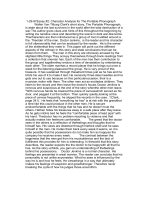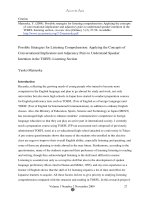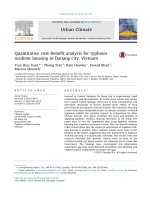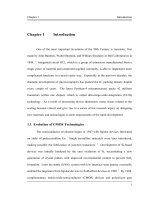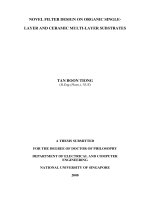Electromagnetic simulation and analysis for novel filter design
Bạn đang xem bản rút gọn của tài liệu. Xem và tải ngay bản đầy đủ của tài liệu tại đây (3.05 MB, 235 trang )
Acknowledgement
I would like to express my most sincere gratitude to my supervisors Associate
Professor Ooi Ban Leong, Professor Prof. Leong Mook Seng and Dr. Guo Li Hui for
their invaluable guidance, suggestions, and constructive criticisms during the
investigation of the project and the preparation of this thesis.
At the same time, I would like to thank my friends and colleagues from our microwave
group and Institute of Microelectronics (IME), Singapore for their support and kind
assistance.
Finally, I would like to express my appreciation to my family and friends, from whom
I received much encouragement in the Ph.D. process.
i
Table of Contents
Acknowledgement ...........................................................................................................i
Table of Contents............................................................................................................ii
List of Figures................................................................................................................vi
List of Tables .................................................................................................................xi
List of Symbols.............................................................................................................xii
Summary ..................................................................................................................... xiii
Chapter 1
Introduction.................................................................................................1
1.1
Literature Review ...........................................................................................1
1.2
Scope of Work ..............................................................................................10
1.3
Achievements and Contributions..................................................................11
1.3.1
List of Journal Publications .................................................................. 12
1.3.2
List of Conference Publications............................................................ 13
Chapter 2
Bi-complex Algebra and Quaternion Electromagnetics ...........................15
2.1
Introduction...................................................................................................15
2.2
Network Quaternion Integral Equation Formulation....................................16
2.3
Mixed Potential Integral Equation Formulation ...........................................31
Chapter 3
A Useful Multilayered Microstrip Pole Extraction Technique.................41
3.1
Introduction...................................................................................................41
3.2
Pole Extraction for Two Layered Structures ................................................44
3.2.1
Introduction........................................................................................... 44
3.2.2
Two-layered Microstrip Geometry in TM Mode.................................. 44
3.2.3
Two-layered Microstrip Geometry in TE Mode................................... 50
3.2.4
Numerical Results and Discussions...................................................... 53
3.3
Extraction of Poles for N-layered Microstrip Geometry ..............................58
ii
3.3.1
Extraction of Surface Wave Poles ........................................................ 58
3.3.2
Extraction of Leaky Wave Poles for N-layered Microstrip Geometry . 65
3.3.3
Extraction of Lossy Improper Poles for N-layered Microstrip Geometry
68
3.3.4
Extraction Algorithm ............................................................................ 68
3.3.5
Numerical Results and Discussions...................................................... 70
Chapter 4
Bandpass Filters Miniaturization ..............................................................76
4.1
Introduction...................................................................................................76
4.1.1
Method of Moment with developed DCIM algorithm ......................... 76
4.1.2
Bandpass filters Miniaturization........................................................... 82
4.2
Basic Structures for Filter Design.................................................................84
4.2.1
Resonator .............................................................................................. 84
4.2.2
Basic Types of Microstrip Bandpass Filters......................................... 86
4.3
4.2.2.1
End-coupled, Half-wavelength Resonator Filters............................. 86
4.2.2.2
Parallel-coupled, Half-wavelength Resonator Filters....................... 87
4.2.2.3
Hairpin-line Bandpass Filters ........................................................... 87
4.2.2.4
Interdigital Bandpass Filters ............................................................. 88
4.2.2.5
Stepped Impedance Resonator (SIR) Filters..................................... 89
4.2.2.6
Dual Mode Resonator Filters............................................................ 89
4.2.2.7
Other Types of Bandpass Filters....................................................... 90
Bandpass Filter Miniaturization for Microstrip Structures...........................91
4.3.1
Bandpass Filter Miniaturization Using PBG ........................................ 91
4.3.1.1
Design Structure of a SIR Bandpass Filter ....................................... 93
4.3.1.2
Design Structure of a SIR Bandpass Filter using PBG..................... 95
4.3.1.3
Experimental Results and Discussions ........................................... 100
iii
4.3.2
New Planar Filter without Using Cross-Coupled Effect .................... 103
4.3.2.1
Intermediate, Dual Mode Microstrip Resonator............................. 104
4.3.2.2
The Proposed Filters ....................................................................... 109
4.3.2.3
Numerical and Experimental Results ............................................. 110
4.3.3
Miniaturized Open-Loop Resonator with Wide Frequency Perturbation
116
4.3.3.1
Preliminary Analysis and Design ................................................... 117
4.3.3.2
Novel Resonator Implementation ................................................... 125
4.3.3.3
Novel Resonator Design ................................................................. 131
4.4
Coplanar Filter Miniaturization Using Advanced Technologies ................134
4.4.1
Novel Miniaturized Coplanar Filter Design Using WTT ................... 134
4.4.1.1
Introduction..................................................................................... 134
4.4.1.2
Fabrication technology ................................................................... 136
4.4.1.3
Coplanar Bandpass Filter Design ................................................... 139
4.4.1.4
Experimental Results and Discussions ........................................... 151
4.4.2
A Modified Miniaturized LTCC Hairpin-combline Resonator .......... 155
4.4.2.1
Introduction..................................................................................... 155
4.4.2.2
LTCC Materials and Structures Used in This Thesis ..................... 155
4.4.2.3
Preliminary Analysis and Design ................................................... 157
4.4.2.4
Two Proposed Designs Using LTCC ............................................. 166
4.4.2.5
Experimental Results and Discussions ........................................... 171
Chapter 5
Conclusions and Future Work ................................................................177
5.1
Conclusions.................................................................................................177
5.2
Recommendations for Future Work ...........................................................180
APPENDIX.................................................................................................................182
iv
Definition of Quaternions .......................................................................................182
Some Properties of Bi-complex Numbers ..............................................................183
Non-commutative multiplication of Quaternions............................................... 183
Associativity of Multiplication of Quaternions .................................................. 184
Conjugation of Quaternions................................................................................ 184
Quaternion Fourier Transform................................................................................185
Basic Quaternion Electromagnetics........................................................................187
Source-free, Homogeneous, Lossless TEM Case............................................... 187
Source-free, Inhomogeneous, Lossless TEM Case ............................................ 191
References...................................................................................................................196
v
List of Figures
Fig. 1
Rotation of the axis.........................................................................................22
Fig. 2
Transmission line models ...............................................................................26
Fig. 3
Initial guess evaluation. ..................................................................................47
Fig. 4
Two-layered microstrip topology ...................................................................48
Fig. 5 A numerical comparisons of the various classical methods in terms of the
residue of the function and the number of iterations. (a)-(b) For the first TM root
of the two-layered microstrip geometry under the case ε r1 < ε r 2 and
k o ≤ k ρ ≤ k o ε r1 . (c)-(d) For the second TM root of the two-layered microstrip
geometry under the case ε r1 < ε r 2 and k o ≤ k ρ ≤ k o ε r1 ....................................55
Fig. 6 A numerical comparisons of the various classical methods in terms of the
residue of the function and the number of iterations. (a)-(b) For the first TM root
of the two-layered microstrip geometry under the case ε r1 < ε r 2 and
k o ε r1 < k ρ ≤ k o ε r 2 . (c)-(d) For the first TE root of the two-layered microstrip
geometry for the case ε r1 < ε r 2 and k o ≤ k ρ ≤ k o ε r1 . .......................................56
Fig. 7 A numerical comparisons of the various classical methods in terms of the
residue of the function and the number of iterations. (a)-(b) For the second TE
root of the two-layered microstrip geometry under the case ε r1 < ε r 2 and
k o ≤ k ρ ≤ k o ε r1 .(c)-(d) For the first TE root of the two-layered microstrip
geometry under the case of ε r1 < ε r 2 and . k o ε r1 < k ρ ≤ k o ε r 2 .....................57
Fig. 8
N-layered microstrip topology........................................................................59
Fig. 9
Initial guess evaluation. ..................................................................................64
Fig. 10
Graphic solution for TM and TE surface and leaky wave modes, where the
x
semicircles represent ± B 2 − x 2 . (a) TM: ± B 2 − x 2 = tan ( x ) . (b) TE:
εr
± B 2 − x 2 = − x cot ( x ) .........................................................................................67
Fig. 11 A numerical comparisons of the two methods in terms of the residue of the
function and the number of iterations. (a)-(b) For the first TM root of the fourlayered microstrip geometry under the case of ε r1 < ε r 2 < ε r 3 < ε r 4 and
k o ≤ k ρ ≤ k o ε r1 ..................................................................................................71
Fig. 12
Schematic of a RWG edge element and the dipole interpretation................77
vi
Fig. 13 Barycentric subdivision of the primary triangle. The triangle’s midpoint is
shown by a white circle. .......................................................................................78
Fig. 14
Photograph of the bandpass filter with SIR..................................................81
Fig. 15
Comparison of measured and simulated results ...........................................82
Fig. 16
Distributed line resonators............................................................................84
Fig. 17
Ring resonator ..............................................................................................85
Fig. 18
Patch resonator .............................................................................................86
Fig. 19
General configuration of end-coupled microstrip bandpass filter ................87
Fig. 20
General structure of parallel (edge)-coupled microstrip bandpass filter ......87
Fig. 21
Layout of a hairpin-line microstrip bandpass filter ......................................88
Fig. 22
General configuration of interdigital bandpass filter....................................89
Fig. 23
Bandpass filter with SIR...............................................................................93
Fig. 24
Structural variation of λg / 2 type SIRs. ......................................................94
Fig. 25
Bandpass filter with SIR and PBG ...............................................................96
Fig. 26
Dimension of one unit PBG structure ..........................................................96
Fig. 27
An EBG unit .................................................................................................97
Fig. 28
Lossless equivalent circuit............................................................................97
Fig. 29
Equivalent circuit of an EBG unit ................................................................97
Fig. 30
Photographs of the proposed bandpass filters ............................................101
Fig. 31
Simulated (MoM) and measured results for the filter with SIR.................101
Fig. 32
Simulated (MoM) and measured results for the filter with SIR and PBG .102
Fig. 33
A typical measured response of a squared open-loop resonator ................104
Fig. 34
Comparison of shifted feed lines ................................................................106
Fig. 35
Equivalent circuit for the parallel direct feed structure ..............................106
Fig. 36
Physical dimensions of the proposed structure ..........................................111
vii
Fig. 37
A photograph of the prototype ...................................................................112
Fig. 38 (a) Comparison of S11 on the effect of the meander loop with and without
the presence of the open-circuit stub; (b) Comparison of S21 on the effect of the
meander loop with and without the presence of the open-circuit stub ...............113
Fig. 39 Comparison between the simulated (MoM) and measured response of the
proposed filter .....................................................................................................114
Fig. 40
The proposed miniaturized resonator with its physical dimension ............115
Fig. 41
The measured and simulated (MoM) responses of the structure in Fig. 40115
Fig. 42
Preliminary structure ..................................................................................118
Fig. 43
Simulated responses of the preliminary structure. .....................................118
Fig. 44
Equivalent circuit of the preliminary structure...........................................119
Fig. 45
(a) Even-mode and (b) odd-mode equivalent circuit..................................119
Fig. 46
Lumped element equivalent circuit for even- and odd-mode.....................120
Fig. 47
Various resonator implementations and their S21 responses. .....................127
Fig. 48
The dimension of the preliminary structure. ..............................................128
Fig. 49 (a) Comparison of measured and simulated (MoM) results and (b) A closedup view of the response. .....................................................................................129
Fig. 50
Comparison of S-parameters with ε r = 9.95 , ε r = 10.2 and ε r = 10.45 .....130
Fig. 51
A novel elliptic filter. .................................................................................132
Fig. 52 Photograph showing (i) the fabricated prototype (parallel feed): area = 49.7
mm2 (ii) the fabricated prototype (orthogonal feed): area = 60.84 mm2, (iii) the
loop resonator [167]: area = 144 mm2. All filters are designed centered at 2.5
GHz. ....................................................................................................................132
Fig. 53 Comparison of the simulated (MoM) and measured responses for Fig. 52 (ii)
............................................................................................................................133
Fig. 54
Frequency response for the loop resonator for Fig. 52 (iii)........................133
Fig. 55
Substrate structures using WTT .................................................................137
Fig. 56
WTT process flow ......................................................................................138
Fig. 57
Layout of a CPW resonator ........................................................................139
viii
Fig. 58
Proposed filter design in reference [181] ...................................................142
Fig. 59
CPW resonator with additional grounded meander lines ...........................143
Fig. 60 Equivalent circuit of the CPW resonator with additional grounded meander
lines.....................................................................................................................144
Fig. 61
Equivalent circuit of the meander lines ......................................................145
Fig. 62
Novel bandpass filter design using WTT ...................................................149
Fig. 63
Proposed filter structure and simulated results...........................................151
Fig. 64
Photograph of the wafer .............................................................................152
Fig. 65
Photograph of the coplanar bandpass filter ................................................153
Fig. 66
Simulated (IE3D) and measured results .....................................................153
Fig. 67
Cross section view of the LTCC substrate .................................................156
Fig. 68
Preliminary structure I. All the other lines and space is 0.1 mm................158
Fig. 69
Simulated (IE3D) results for preliminary structure I for Fig. 68 ...............159
Fig. 70
Approximated equivalent circuit for preliminary structure for Fig. 68......159
Fig. 71
Preliminary structure II...............................................................................165
Fig. 72
Simulated (IE3D) results for preliminary structure II ................................166
Fig. 73
Proposed coplanar bandpass filter ..............................................................168
Fig. 74
Simulated (IE3D) results for the structure in Fig. 73 .................................168
Fig. 75
Dimensions of the proposed two-layered filter design...............................170
Fig. 76
Simulated (IE3D) results for the proposed two-layered design .................171
Fig. 77
Photographs for the proposed designs: (i) Single-layered CPW bandpass
filter as shown in Fig. 73, (ii) Two-layered CPW bandpass filter with via as
shown in..............................................................................................................173
Fig. 78
Simulated (IE3D) and measured results for Design (i) in Fig. 77..............173
Fig. 79
Comparison of S-parameters with ε r = 5.7 , ε r = 5.9 and ε r = 6.1 ............174
Fig. 80
Simulated (IE3D) and measured results for Design (ii) in Fig. 77.............175
ix
Fig. 81
Comparison of S-parameters with ε r = 5.7 , ε r = 5.9 and ε r = 6.1 ............176
Fig. 82
Properties of the three fundamental elements ............................................182
x
List of Tables
Table 1
Equations for the transmission line model...................................................27
Table 2 Two sets of Maxwell equations for electric current-source free and
magnetic current-source free ................................................................................31
Table 3
Two possible forms for both G A and G M in the ( u, v ) plane.....................35
Table 4 Comparison of the proposed approach and the Davidenko’s method [126]
for leaky-wave poles extraction in TM mode. The parameters adopted are
ε r1 = 15 , ε r 2 = 59 , ε r 3 = 37.5 , h1ko = 0.8 , h2 ko = 0.9 , h3 ko = 0.95 , and
ε r1 ko < k ρ < ε r 3 ko . ...........................................................................................72
Table 5 Comparison of the proposed approach and the Davidenko’s method [126]
for lossy improper poles extraction in TM mode. The parameters adopted are
ε r1 = 35.5 + i0.1 , ε r 2 = 37.5 + i0.1 , ε r 3 = 59 + i0.1 , h1ko = 0.4 , h2 ko = 0.4 , and
h3 ko = 0.5 ..............................................................................................................74
Table 6 Comparison of the proposed approach and the Davidenko’s method [126]
lossy improper poles extraction in TM mode. The parameters adopted are
ε r1 = 40 + i 25 , ε r 2 = 75 + i 25 , ε r 3 = 40 + i 25 , ε r 4 = 80 + i 25 , h1ko = 0.4 ,
h2 ko = 0.45 , h3 ko = 0.4 , and h4 ko = 0.45 . .............................................................75
Table 7
Material properties for LTCC used in this section ....................................157
xi
List of Symbols
εo
Permittivity of free space ( 8.854 × 10−12 F/m)
µo
Permeability of free space ( 4π × 10 −7 H/m)
η
Free space wave impedance ( Ω )
ko
Free space wave number (rad/m)
λ
Wavelength (m)
E
Electric field (V/m)
H
Magnetic field (A/m)
A
Magnetic vector potential (Wb/m)
J
Electric current density (A/m2)
xii
Summary
Various numerical techniques have been developed to efficiently and accurately
calculate the fields of a layered medium. Traditionally the electric and magnetic fields
are derived separately. With the concept of quaternion algebra, a novel and compact
quaternion formulation is derived for EM analysis. The resultant formulation is
subsequently utilized in the Method of Moments (MoM), which is a powerful
technique to analyze planar passive circuits. The MoM used herein requires the
Green’s function in the spatial domain. The closed-form Green’s function can be
obtained using the Discrete Complex Image Method (DCIM), which needs the
accurate evaluation of the poles of the Green’s function in the spectral domain. The
extraction of the poles of the Green’s function is one of the bottlenecks for the analysis
of multilayered structures due to the complexity of the multilayered Green’s function.
Although several methods have been introduced for pole extraction, they are not
efficient and accurate enough. Thus, a fast, stable and efficient multilayered pole
extraction technique for fast evaluation of DCIM is introduced in this thesis. Suitable
initial guesses, good convergence and accuracy have been achieved through our
method. The MoM algorithm is next used to design and analyze novel bandpass filters.
Several miniaturization techniques for bandpass filter design have been explored for
the first time. These include the Photonic Bandgap (PBG) structure, dual mode
resonator without cross coupling effect, novel miniaturized open-loop resonator with
wide frequency perturbation, novel coplanar filter design with Wafer Transfer
Technology (WTT) and a modified miniaturized LTCC hairpin-combline resonator.
xiii
Chapter 1
Introduction
1.1 Literature Review
The electromagnetic field computation in layered media plays a crucial role in certain
applications, such as geophysical prospecting [1]–[3], remote sensing [4], wave
propagation [5]-[6], and microstrip circuits and antennas [7]–[9]. Researchers have
developed many computationally efficient and accurate numerical techniques for the
field computation of layered media. To name a few, these include the method of
moments (MoM) and its variants [10], the finite-element method (FEM) [11], and the
finite-difference time-domain (FDTD) method [12].
In general, the FEM and the FDTD method solve differential equations, whereas MoM
deals with the integral equations. MoM is a more powerful and efficient method for
solving problems with simple planar geometry compared to FEM and FDTD. FEM
[13] and FDTD [14] are more suitable for arbitrarily shaped, inhomogeneously filled
and anisotropic scatterers, but are not particularly efficient at modelling the finite
source region, especially when it is necessary to describe it in details. In here, the
source cannot be easily described as dirac function.
For solving planar layered microstrip and coplanar waveguide (CPW) structures, the
MoM is regarded as one of the most popular techniques [15]-[16]. For the MoM
formulation, an integral equation describing the electromagnetic problem can be
formulated as the mixed potential integral equation (MPIE) or the electric field
integral equation (EFIE). These integral equations require the evaluation of problemdependent Green’s functions, which can be assumed to have the forms of the vector
1
and scalar potentials based on MPIE formulation or the electric fields based on EFIE
formulation. In general, the MPIE equation provides a less singular kernel compared
with the EFIE equation for analyzing multilayered structure.
The MoM analysis can be carried out either in the spectral domain [17]-[18] or in the
spatial domain [19]–[22]. In the spectral domain formulation, the MoM matrix
elements involve two-dimensional (2-D) integrals of complex, oscillatory, and slowconverging functions over an infinite domain [23]. Therefore, the numerical evaluation
of these elements is quite time consuming, rendering the technique computationally
inefficient. Although acceleration techniques and approximations can improve the
computational efficiency of the spectral-domain MoM, they may impose some
restrictions. The basis and testing functions are restricted to those that have analytical
Fourier transforms, such as the rooftop [24] and piecewise sinusoidal basis functions
[25]. On the other hand, the application of the spatial-domain MoM to the mixedpotential integral equation (MPIE) requires the evaluation of Green’s functions in the
spatial domain [15]. The spatial-domain Green’s functions can be obtained from their
spectral domain counterparts, which can be derived analytically for planar
multilayered media, via the Hankel transformation, also called Sommerfeld integral
[26]- [27]. Since the kernel of the transformation is the Bessel function of the first kind
and the function to be transformed is the spectral-domain Green’s function, the
integrand is often an oscillatory and slow-converging function. Therefore, the
calculation of the spatial domain Green’s function, i.e., the numerical implementation
of the Hankel transformation, is the main computational bottleneck of the spatialdomain MoM. The spatial-domain MoM has no restriction on the basis and testing
2
functions [28]. In this thesis, a spatial-domain MoM is used to analyze planar
structures.
In modeling microstrip structures using the MoM, much effort has been devoted to the
computation of the Green’s functions because the computation of Sommerfeld
integrals (SIs) is very time consuming. There are three methods that can be found in
the literature for the evaluation of these SIs: (1) numerical integration method; (2)
asymptotic method; (3) discrete complex image method. The numerical integration
method in [29]-[30] is suitable only when the field points are very close to the source
points. Generally, this method requires the largest computation time because the
integrands are oscillatory. The asymptotic method [31] is the fastest, but it is also the
least accurate, especially when the field points are close to the source points. They are
also complicated and cannot be directly used for multilayered microstrip structures. To
address these limitations, a method based on the Sommerfeld identity, called the
discrete image method (DCIM) [33]–[48], has been developed. The DCIM
approximates the spectral-domain Green’s functions in terms of complex exponentials
and casts the integral representation into closed-form expressions via an integral
identity, namely the Sommerfeld identity [49].
The DCIM divides the Green’s function into three main parts [34]. They are namely:
(1) extraction of the quasi-static terms dominating in the near-field region, (2)
contributions of the surface wave poles (SWP) dominating in the far-field region of the
substrate surface, and their extraction, and (3) the remaining terms, which are related
to leaky waves and are very important in the intermediate field region. The quasi-static
contribution is inverse transformed analytically through the Sommerfeld identity. The
3
surface wave contribution comes from the poles in the spectral Green’s functions. The
surface wave poles are extracted, and subsequently the contribution of surface waves
is evaluated through the residue calculus. The remaining portion in the spectral
representation is expanded into a series of exponentials using either the Prony [34] or
generalized pencil-of-functions method (GPOF) methods [38], [50].
Conventionally, both the vector magnetic potential A and the vector electric potential
F are evaluated separately through the mixed potential formulation. To achieve more
compactness in the derivation, a novel quaternion mixed potential formulation is
presented in the thesis. In reference [51], concepts of quaternion Fourier transform
(QFT), quaternion convolution (QCV), and quaternion correlation, which are based on
quaternion algebra, have been found useful in the solution of Maxwell’s equations. It
has been shown that the derivation of regular TEM waves in homogeneous medium
can be given in a very compact way, yielding all possible polarization cases
simultaneously. In this thesis, a new way of representing the dyadic Green’s function
in a compact form has been introduced based on the concepts of quaternion algebra in
[51].
Several issues need to be considered when applying DCIM method for multilayered
structures. One of them is the difficulty of extracting the surface wave poles for the
multilayered structures. In applying DCIM to general multilayered media, there is a
lack of a reliable procedure for the extraction of surface wave components [41]. In [52]
and [53], a Newton–Raphson root-searching procedure is applied to find the TE- and
TM-mode surface wave poles of a grounded dielectric slab. However, due to the
existence of branch cuts, the initial values close to the roots are needed. In this
4
connection, reliable and suitable initial values need to be investigated for the grounded
dielectric slab, but such initial values for general multilayered media are not available.
In [54] a contour integral method is used for seeking the zeros of an analytical function,
which are the surface wave poles of three-layered media grounded both at the top and
bottom. In [55] the same method is applied to a three-layered medium which is
grounded only at the bottom by eliminating the branch points associated with the semiinfinite top layer through a variable transform. However, this method requires
evaluation of the first-order derivative of the function, the zeros of which are to be
sought, which is difficult to derive for general multilayered media. When the number
of zeros in the contour is greater than four, the contour should be replaced by several
smaller contours so that each contains no more than four zeros. This process is
generally rather tedious. In [56], a two-stage root-searching procedure is proposed for
seeking the roots of these denominators. The residuals associated with the surface
wave poles are calculated through contour integration. To find all the roots
automatically, the interval between the minimum and maximum wave number of all
media is divided uniformly into a number of sections. For each section, the golden
search procedure is first applied to find the minimum of F ( k ρ ) [56], which is then
used as the starting point for the Newton– Raphson procedure. In general, this
method is not very efficient since it cannot find the total number of the roots
automatically and it has difficulties to seek the initial values for the surface wave poles.
Also, this method suffers from local minimum termination. In [57], an efficient and
robust iterative algorithm is introduced based on contraction mapping, which can
locate all the proper and improper solutions of the characteristics equations of the
grounded dielectric slab. However, this method will become extremely complex when
it is extended to multilayered structures and the functional form, which is crucial for
5
the accurate evaluation of the overall spatial Green’s function, is difficult to find. As a
result, there is a need to devise an efficient, accurate and fast poles extraction
algorithm for multilayered structures. Our earlier success in deriving fast but efficient
pole extraction procedure for a single-layered structure [58] provided a good starting
point for deriving a generalized approach for multilayered microstrip pole extraction.
In this thesis, a general and fast algorithm is introduced for surface wave, leaky wave
and lossy pole extraction for multilayered structures.
Another difficulty associated with the DCIM method is the approximation method for
the complex image terms. The original derivation of the closed-form Green’s functions,
as proposed in [34], employed the original Prony method for complex image terms. It
was limited in use to thick and single layer structures, which was due to inadequacy of
the original Prony method. This problem was eliminated by employing the least
squares Prony method [35]. Then the approximation was further improved by using
the generalized pencil-of-functions method (GPOF) [38], which is less noise sensitive
and more robust compared to the Prony methods. However, the algorithm for the
exponential approximation is still computationally expensive, because Prony’s
methods and the GPOF method require uniform sampling of the function to be
approximated along the range of approximation. This, in turn, makes it necessary to
take a large number of samples for functions with local oscillations and fast variations,
like spectral-domain Green’s functions in general, rendering the algorithm
computationally expensive and not robust. Recently, a two-level approach that
requires piecewise uniform sampling has been introduced to eliminate this problem,
and is demonstrated to be much more efficient and robust [40]. Hence, the spatial-
6
domain closed-form Green’s functions can be employed efficiently in the solution of
MPIE for planar, multilayered geometries.
With the appropriate spatial-domain Green’s function and boundary conditions, the
surface current of a specified problem can be calculated. Based on the appropriate
integral equation, we need to expand the unknown function in terms of some known
basis functions with unknown coefficients. The preferred choice of basis functions is
the one developed by Rao et al. [59], which is now commonly known as the Rao–
Wilton–Glisson (RWG) basis function. This basis function provides a great capability
to model arbitrarily shaped microstrip structures. The boundary conditions are then
implemented in an integral sense through the testing procedure. The integral equation
is next transformed into a matrix equation, whose entries are double integrals for the
general 2-D geometries. However, for planar 2-D geometries, the MoM matrix entries
can be reduced to single integrals by transforming the convolution integrals onto the
basis and testing functions and by evaluating the resulting integrals analytically [60].
In either domain, for moderate-size geometries the computational efficiency of the
MoM lies in the evaluation of the MoM matrix entries. In the spectral-domain
application of the MoM, since the Green’s functions are known in closed form, the
matrix entries become single integrals over an infinite domain. For a geometry
requiring a large number of unknowns, the matrix solution time dominates the overall
performance of the technique, and therefore, the efficiency of the method is defined by
the efficiency of the linear system solver [61].
The MoM is a powerful technique to analyze planar passive circuits, such as antennas
and
filters.
With
the
widespread
evolution
of
wireless
communications,
7
miniaturization for personal communications equipment has become one of the most
fundamental requirements. Since many of the passive circuits are made of filter
structures, there is a need to investigate miniaturization of the filters. Filters can be
categorized into bandpass filters, bandstop filters, lowpass filter and highpass filters.
Among them, the bandpass filter plays a pivotal role in wireless communications
systems such as satellite and mobile communications systems.
In general, bandpass filters can be designed based on single- or multiple-resonator
structures. Microstrip resonators for filter designs may be classified as lumped-element
or quasilumped-element resonators, distributed line resonators or patch resonators.
Conventional bandpass filters include stepped-impedance filters [62]-[66], open-stub
filters [67]-[68], semi-lumped element filters [69], end- [70] and parallel-coupled [71][72] half-wavelength resonator filters, hairpin-line filters [73]-[75], interdigital [76][79], combline filters [80]-[81], pseudo-combline filters, and stub-line filters [82].
Recently some research has been conducted on designing compact, low-loss bandpass
filters with good performance. In view of this, we will focus on miniaturization of
microstrip and coplanar bandpass filters in this thesis. To minimize the size of the
bandpass filter, several structures have been demonstrated including the steppedimpedance resonators (SIR)
[62]-[66], the dual mode resonators [83]- [85],
meandered open loop resonators [86]-[88], and the photonic bandgap structures [89].
Conventionally, filters using uniform impedance resonators (UIRs) [91] were first
used in microwave communication systems. They suffer from poor harmonic
suppression. To alleviate the problem, the stepped impedance resonator (SIR) was
developed to solve the problem. Stepped impedance resonators (SIR) are composed of
8
transmission lines with different characteristic impedances. They provide an effective
way to minimize circuit space and push spurious resonant frequencies away from the
passband [62].
Dual-mode resonators are one of the most effective means for miniaturizing a
bandpass filter (BPF). Dual-mode [90] means that two degenerate resonant modes are
excited by asymmetric feed lines and by the addition of notches or stubs on the ring or
patch resonators. Therefore, the perturbed resonator may be used as a doubly-tuned
resonant circuit. Consequently, the number of resonators for a n -degree filter can be
reduced by half, and the overall size of the filter can be compacted [91]-[92]. A dualmode square patch resonator has been used to build Chebyshev and Elliptic filters [93].
Conventional square patches suffer from large size. As a result of this, several novel
dual-mode structures have been introduced in this thesis for filter miniaturization.
Photonic bandgap (PBG) structures are specific periodic structures artificially created
in materials such as metals or substrates to influence or even change the
electromagnetic properties of materials. These PBG structures can be integrated in
many microstrip filters so as to increase the maximum attenuation at the stopband,
suppress the spurious transmission and reduce the overall circuit area.
For filter implementation, the available technologies include the microstrip line and
coplanar waveguide (CPW). Microstrip bandpass filters are finding wide range of
applications in many RF/microwave circuits and systems owing to their low-cost, light
weight and ease of integration with other components on printed circuit boards (PCBs).
However, ground connections in microstrip require either a metallised via hole
9
through the substrate or else a wrap-around metallization at the edge of the substrate.
Both of these techniques increase the meanufacturing complexity and hence the cost.
Unlike microstrip or stripline, coplanar waveguide has the ready access to the ground
plane on the topside of the substrate and permits easy parallel and series insertion of
circuit components. Its circuit parameters are also less sensitive to the substrate
thickness, but sensitive to other parameters. For filter miniaturization, the available
techniques include using slow wave structures [94], meander line structures [95]- [96],
or slot-loaded CPW structures [97]- [98].
Besides the above-mentioned novel structures for filter design, there are also many
advanced materials and technologies currently available for filter fabrication. They
include the high-temperature superconductors (HTS) [99]-[102], ferroelectrics,
micromachining or microelectromechanical systems (MEMS) [103]-[105], hybrid or
monolithic microwave integrated circuits (MMIC) [106]- [107], active filters, photonic
bandgap (PBG) materials/structures, low-temperature cofired ceramics (LTCC) [108][109] and wafer transfer technology (WTT). These technologies have stimulated the
rapid development of new bandpass filters. In this thesis, we will introduce several
novel structures of bandpass filters for microstrip structure and CPW using
conventional and advanced fabrication technologies.
1.2 Scope of Work
In Chapter 1, an introduction to the history and current research concerning EM
modeling for multilayered structures is presented. Different numerical techniques have
been investigated to efficiently and accurately calculate the fields of layered medium.
It is noted that the Method of Moments is a powerful technique to analyze planar
passive circuits. In general, MoM requires the Green’s function in spatial and spectral
10
domains. In this research, the development of closed-form spatial-domain Green’s
function are investigated using EM simulation. Various techniques of filter
miniaturization are introduced.
Chapter 2 introduces a novel and compact quaternion analysis for EM analysis.
Normally, the electric and magnetic fields are derived separately. With the concept of
quaternion algebra, it is possible to give a compact formulation for DCIM analysis.
A multilayered pole extraction technique for fast evaluation of DCIM is introduced in
Chapter 3. Extracting the poles of the Green’s function is one of the difficulties for the
analysis of multilayered structures due to the complexity of the multilayered Green’s
function. Although several authors provide some techniques for pole extraction, these
methods are not very efficient and accurate. Thus, there is a need to investigate a new
general and fast algorithm for pole extraction in multilayered structures.
MoM can be used to design and analyze different planar circuits. Various novel
bandpass filter designs are investigated in Chapter 4. As the design of compact, lowloss and good performance bandpass filter has attracted a lot of attention recently, all
the filters introduced in this chapter focus on miniaturization, which provide low cost
and good performance.
Several advanced design and fabrication techniques are
applied for further miniaturization of bandpass filters compared to the conventional
PCB technology.
1.3 Achievements and Contributions
As a result of the research work, the following contributions have been achieved:
11
a) A novel and compact quaternion analysis has been derived. Without separately
deriving the electric and magnetic field, the quaternion MPIE provides a faster
formulation method for the DCIM analysis.
b) A multilayer pole extraction technique for fast evaluation of DCIM has been
developed during the project work. Suitable initial guesses and good functional
expressions with fast convergence have first been derived. Compared to the
conventional methods, good convergence and accuracy are achieved. The
method is noted to be fast and stable, and does not suffer from local minimum
termination.
c) Several miniaturization techniques for bandpass filter design have been
explored for the first time. These includes the PBG structure, dual mode
resonator without cross coupling effect, novel miniaturized open-loop
resonator with wide frequency perturbation, novel coplanar filter design with
Wafer Transfer Technology (WTT) and miniaturized two-layered LTCC
coplanar filter using modified hairpin-combline resonator.
As a result of these investigations, the following publications have been produced:
1.3.1 List of Journal Publications
z
Y. Wang and B. L. Ooi, “Useful multilayered microstrip pole extraction technique”,
IEE Proceedings Microwaves, Antennas and Propagation, Vol. 152, Issue 3, pp.
149 – 154, June 2005.
z
Y. Wang, B. L. Ooi, M. S. Leong, “Efficient and fast approach for surface wave
poles extraction in two-layered microstrip geometry”, Microwave and Optical
Technology Letters, pp. 253-258, May 2004.
z
H. Y. Fong, Y. Wang, B. L. Ooi, “A novel microstrip loop filter”, Microwave and
12
